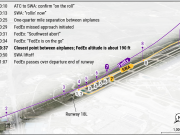
The following information provides an awareness of problems that might be avoided in the future. The information is based on final reports by official investigative authorities on aircraft accidents and incidents.
Jets
Missed by 100 Meters
Airbus A320, Boeing 737. No damage. No injuries.
An unresolved misinterpretation of a taxi clearance issued by a tower controller to the A320 flight crew and an approach controller’s late handoff of the 737-900 to the tower controller were among the factors that contributed to a near-collision on the runway at Yogyakarta, Indonesia, according to the country’s National Transportation Safety Committee.
The committee’s final report on the serious incident credited the actions of the flight crew of the landing 737 with narrowly avoiding a collision with the A320, which had inadvertently been taxied onto the active runway.
The near-collision occurred the morning of Nov. 20, 2013, shortly after Yogyakarta’s Adisutjipto International Airport was reopened following a brief suspension of operations due to heavy rain.
Weather conditions had improved to 6 km (4 mi) visibility and a broken ceiling at 1,800 ft. Although the surface winds favored Runway 27, the 737 crew was using the instrument landing system to approach and land, with a 9-kt tailwind, on Runway 09.
The A320 was parked at a ramp on the north side of the airport, and the crew was cleared by the tower controller to taxi to the holding point for Runway 27 via Taxiway N2, which is about 450 m (1,476 ft) from the approach end of that runway.
The pilot-in-command (PIC) of the A320 believed that the holding point for Runway 27 was on Taxiway N3, which led directly to the approach end of that runway. He apparently was not aware of a notice to airmen (NOTAM) advising that N3 was available for use only by arriving aircraft, to exit the runway after landing on Runway 09 and to taxi to the ramp.
The A320 PIC requested clearance to taxi directly to N3, but the tower controller “reconfirmed that the taxiway was N2,” the report said. At no time did the controller specifically instruct the crew to hold short of Runway 27 on N2.
There was no further communication between the tower controller and the A320 crew, who still believed that the holding point was on Taxiway N3 and apparently proceeded on the assumption that they had been cleared via Taxiway N2 to back-taxi on the active runway and to hold short adjacent to N3.
Meanwhile, the approach controller had cleared the 737 crew to land if the runway was in sight. The report said that this clearance did not comply with standard operating procedure requiring arriving aircraft to be transferred from “Yogya Approach” control to “Adi Tower” control when the aircraft were at 2,500 ft on final approach.
The 737 was 3.5 nm (6.5 km) from Runway 09 and at 1,500 ft when the crew reported that they had the runway in sight. “The Yogya Approach controller advised the pilot to contact the Adi Tower controller after landing,” the report said.
About this time, the A320 crew inadvertently had begun to taxi off N2 and onto the runway. The PIC saw the 737 on approach and applied wheel brakes and reverse thrust. The A320 came to a stop perpendicular to the runway and with its nose extending about 16 m (52 ft) onto the runway. The Airbus was about 1,750 m (5,742 ft) from the approach end of Runway 09.
The 737 was descending through about 600 ft when the tower controller saw that the A320 was on the runway. He told the A320 crew to stop and advised the approach controller to instruct the 737 crew to go around.
“However, the Yogya Approach controller did not instruct the [737 crew] to go around, as he assumed that the aircraft was on short final and a go-around might jeopardize the safety of the flight,” the report said.
The Adi Tower controller radioed the 737 crew to go around. However, having been instructed to contact the tower controller after landing, the 737 pilots were still monitoring the approach control radio frequency.
Shortly after touchdown, the 737 crew saw the A320 ahead. “The pilot then applied maximum manual braking and full thrust reverse, and the aircraft stopped approximately 100 meters [328 ft] from the [A320],” the report said. “The [737] pilot’s action had avoided a collision between the aircraft.”
Mud Daubers at Work
Airbus A330. No damage. No injuries.
The A330 was on the ground at Brisbane Airport in Queensland, Australia, for only about two hours while being prepared for its return flight to Singapore on Nov. 21, 2013. That was enough time for a mud-dauber wasp to almost completely block the captain’s pitot probe.
The Australian Transport Safety Bureau (ATSB) report said that mud-dauber wasp activity was a known hazard at Brisbane Airport. Nevertheless, the operator of the A330 did not require maintenance crews to install covers on pitot and total air temperature probes during relatively brief ground times at the airport.
As the flight crew initiated the departure for the return flight to Singapore, the captain noticed a red airspeed flag on his primary flight display (PFD) and rejected the takeoff at about 50 kt.
After the aircraft was taxied back to the terminal, a maintenance engineer performed tests with built-in test equipment but identified no faults. The aircraft was released for service after adjustment of air data sources per the minimum equipment list. The report noted that the aircraft operator’s maintenance troubleshooting procedures at the time did not require checks for pitot probe blockage.
During the second takeoff attempt, the flight crew saw a red flag appear on the captain’s PFD. Because the aircraft already had reached V1 (151 kt), they continued the takeoff. The crew subsequently declared an emergency and landed the A330 without further incident.
“Engineering inspection after the overweight landing found that the captain’s pitot probe was almost totally obstructed by an insect nest, consistent with mud-dauber wasp residue,” the report said.
Following the incident, the aircraft operator adopted a policy of always using pitot covers on aircraft at Brisbane Airport, regardless their time on the ground. The report said that the operator also “amended its maintenance troubleshooting manual to increase the likelihood that a blocked pitot probe will be detected.”
The report noted that the incident also prompted the airport operator to extend its wasp inspection and eradication program.
Low-Visibility Lineup
Gulfstream GIII. Destroyed. No injuries.
Visibility at Biggin Hill Airport near London generally was good the night of Nov. 24, 2014, but there were patches of fog on the first half of Runway 03. As the flight crew of the GIII taxied for takeoff on the runway, the ground controller advised that visibility in the fog patches was not measured but “seems to be very low,” said the report by the U.K. Air Accidents Investigation Branch (AAIB).
After lining up on Runway 03, “the crew believed that the lights they could see ahead were runway centreline lights when they were actually runway edge lights,” the report said.
The edge lights were about 3 m (10 ft) from the right side of the runway. The runway was not equipped with centerline lights.
Shortly after the takeoff was initiated, the right main landing gear ran off the paved surface and onto grass off the right side of the runway. The pilot rejected the takeoff at about 70 kt as the Gulfstream veered off the runway.
The report said that the GIII was damaged beyond economic repair after the nose landing gear collapsed. The five passengers and the pilots were not hurt.
TURBOPROPS
Night VFR Into IMC
Cessna 208B. Substantial damage. Four fatalities, six serious injuries.
Although company procedure required a verbal evaluation of the risks involved in the night visual flight rules (VFR) commuter flight, there was no discussion between the pilot and flight coordinator of the likely instrument meteorological conditions (IMC) or the contaminated runways at the destination airports before the Caravan departed from Bethel, Alaska, U.S., for the first leg of the trip, to Mountain Village, on Nov. 29, 2013.
The pilot subsequently found that the weather conditions at Mountain Village had deteriorated, and he requested and received a special VFR clearance to the second destination, St. Mary’s.
“Witnesses in the area described the weather at the airport as deteriorating with fog and ice,” said the report by the U.S. National Transportation Safety Board (NTSB).
The pilot used the wrong radio frequency for the pilot-controlled lighting system and was unable to activate the airport lights. The witnesses saw the airplane fly over and away from the airport. The report said that the Caravan then entered a descending right turn and struck terrain. Three passengers and the pilot were killed, and the other six passengers sustained serious injuries.
“Post-accident examination of the airframe and engine revealed no mechanical malfunctions or anomalies that would have precluded normal operation,” the report said. “About 3/4 in [19 mm] of ice was noted on the nonprotected surfaces of the empennage. However, ice formation on the airplane’s inflatable leading edge deice boots was consistent with normal operation of the deice system.”
The report noted that the accident occurred during the pilot’s fifth flight of the day and more than 10 hours after he reported for duty.
Overburdened by Ice
Cessna 208B. Destroyed. No injuries.
Freezing drizzle at the destination the night before had necessitated rescheduling the flight from Yellowknife to Fort Simpson, both in Canada’s Northwest Territories, to the morning of Nov. 20, 2014.
“Its early morning departure was intended to enable the regularly scheduled return flight to depart [from Fort Simpson] at 0800 with minimal delay,” said the report by the Transportation Safety Board of Canada.
During preflight preparations, the pilot learned that the area forecast called for moderate mixed-icing conditions from 2,000 ft to 14,000 ft along the route. “However, the pilot misread the [forecast] and assumed that icing conditions were moderate rime from 2,500 to 4,000 ft,” the report said.
“As well, there was a general belief among company pilots that the [forecasts] for the region were overly conservative and that their accuracy was unreliable in regard to forecast icing conditions. This belief led to the minimization of the information available and a lack of vigilance in its use.”
The Caravan departed from Yellowknife at 0642 local time and was cleared to climb to 8,000 ft. The aircraft encountered icing conditions while climbing through 6,000 ft and did not accelerate beyond 120 kt (about 36 kt lower than normal) after the pilot set cruise power at 8,000 ft. Indicated airspeed then began to decrease, and the pilot was unable to maintain altitude.
He requested and received clearance to descend to a lower altitude, 6,000 ft. “During the controlled descent, airspeed continued to decline below 120 kt, even with the application of maximum continuous power,” the report said.
At 0706, the pilot told air traffic control (ATC) that he was returning to Yellowknife due to the severe icing conditions. “The pilot began experiencing periods of elevator buffeting and uncommanded forward pitch movements during the turn [back to Yellowknife],” the report said. “He continued the descent in order to maintain 110 kt.”
ATC cleared the pilot to descend to 2,100 ft, the minimum vectoring altitude. However, the pilot was unable to maintain that altitude and declared an emergency. A series of “wing drops” occurred as the Caravan descended at 1,200 fpm through 300 ft above ground level (AGL) at 100 to 110 kt and maximum continuous power.
The pilot pushed the power levers full-forward, but the aircraft continued to descend. It touched down on the frozen surface of a lake about 18 nm (33 km) from the airport at 0721. The Caravan was destroyed when it struck a rock outcropping, but the pilot and his five passengers escaped injury.
Investigators found that, on departure, the aircraft was 342 lb (155 kg) over maximum weight for flight in icing conditions and that the center of gravity (CG) was forward of the limit.
“The pilot was unaware of the actual aircraft weight and balance before departure and of the effects on aircraft controllability that could be expected as a result,” the report said. “Increased weight results in an increased stall speed and degraded climb performance. The forward CG aggravated the situation by increasing the angle of attack and stall speed, further narrowing the margin of safety.”
PISTON AIRPLANES
Loose Engine Oil Fitting
Aero Commander 500A. Substantial damage. One fatality.
The pilot was receiving flight-following services during a positioning flight from Houston to Austin, Texas, U.S., the morning of Nov. 23, 2014. He made no further radio transmissions after reporting that he was beginning the descent to Austin.
The Aero Commander was last shown on ATC radar at 90 ft AGL with a groundspeed of 66 kt. The wreckage was found in an open field near McDade, Texas. “Impact signatures were consistent with a stall/spin, which had resulted in a near-vertical impact at a slow airspeed,” the NTSB report said.
Investigators found that the oil gauge housing on the right engine had not been secured properly and that oil exhaustion had led to the mechanical failure of the engine.
“Cockpit switches were positioned in accordance with the in-flight shutdown of the right engine,” the report said. “Despite [having] one operating engine, the pilot did not maintain adequate airspeed and exceeded the airplane’s critical angle-of-attack, which resulted in an aerodynamic stall/spin.”
Based on finding that the autopilot roll, heading and pitch modes were engaged on impact, the NTSB concluded that “it is likely that the autopilot was controlling the airplane’s flight path before the stall.”
Forced Landing on Beach
Pilatus Britten-Norman Islander. Substantial damage. No injuries.
The pilot and four crewmembers were dispatched the night of Nov. 3, 2013, to search for two fishermen who were either in the water or in a dinghy near England’s Channel Islands, where the Islander was based.
The AAIB report described the weather conditions in the search area as very poor, with surface winds gusting to 41 kt, clouds below 1,000 ft and visibility from 3 to 6 km (2 to 4 mi).
The pilot later told investigators that preflight preparations were marked by “a lot of urgency.” The crewmember who conducted the preflight inspection of the aircraft did not check fuel quantities and told the pilot so. “The pilot ‘walked round’ the aircraft, though he did not carry out a formal pre-flight inspection,” the report said.
The preflight checklists subsequently were conducted from memory, and the pilot apparently did not notice that the fuel selectors had been left positioned to the tip tanks after a previous flight.
“The aircraft departed on the accident flight in the same configuration, and the engines stopped when the tip tank fuel became exhausted,” the report said.
The Islander was about 500 ft above the water at the time. The pilot described the weather conditions as awful and ghastly, requiring him to devote his full attention to flying the aircraft.
When the left engine failed, the pilot declared an emergency and turned toward Jersey. After the right engine also lost power, “he trimmed the aircraft for a glide, still heading towards the airport at Jersey but with very limited visual references outside the cockpit.” The other crewmembers prepared for a ditching.
“Despite the dark night and turbulent weather conditions, the pilot was able to reach the Jersey coast. … The pilot glimpsed something green in front of the aircraft and flared for landing,” the report said. “The aircraft touched down and decelerated, sliding downhill and passing through a hedge. … It came to a halt when its nose lodged against a tree, with significant airframe damage.” None of the occupants was injured.
HELICOPTERS
Cover Blown Into Fenestron
Eurocopter EC-135. Substantial damage. No injuries.
The pilot lifted off into a low hover and was preparing to make a right pedal turn into the wind when the emergency medical services helicopter began to spin right. “The pilot lowered the collective, and the helicopter rotated approximately 150 degrees, then impacted the ground and continued to rotate another 20 to 30 degrees” before coming to a stop, said the NTSB report.
The helicopter was substantially damaged, but the two medical crewmembers, the patient and the pilot were not hurt. The accident occurred in Monongahela, Pennsylvania, U.S., on Nov. 6, 2015.
Investigators found that main-rotor wash had blown the cover off a wheel-equipped fire extinguisher. The cover then was ingested by the helicopter’s fenestron (tail rotor). “The wheeled fire extinguisher that the cover had blown off of had been inspected for serviceability just four days prior to the accident,” the report said.
Destroyed by a Grass Fire
Robinson R44. Destroyed. No injuries.
The R44 had been rebuilt after a hard landing, and the pilot became concerned about the overhauled engine’s excessive oil consumption during the first four hours of flight following the rebuild, according to the ATSB report.
The maintenance technician who had installed the overhauled engine recommended that the pilot take the helicopter for a long flight of about seven hours to “bed in” (improve clearance between) the engine’s piston rings and cylinder wall.
At the pilot’s request, an employee of the company that had overhauled the engine went along on the flight, which began in Mareeba, Queensland, Australia, and proceeded north along the coast the morning of Nov. 22, 2014.
The pilot made several stops, topping off the oil reservoir and wiping oil off the cylinders and cowling each time, during the northbound flight to Coen.
Shortly after departing from Coen for the return flight to Mareeba, engine speed decreased rapidly. The pilot conducted a successful autorotative landing in a clearing, but heat from the engine’s exhaust ignited the tall grass in the clearing.
The pilot and passenger exited and ran to safety as the helicopter became engulfed in flames. The R44 was destroyed by the fire, and the damage precluded investigators from conclusively determining what had caused the engine to fail.
| Date | Location | Aircraft Type | Aircraft Damage | Injuries |
|---|---|---|---|---|
|
NA = not available This information, gathered from various government and media sources, is subject to change as the investigations of the accidents and incidents are completed. |
||||
| Aug. 1 | Nong Prue, Thailand | Piper Chieftain | destroyed | 1 fatal, 2 serious, 1 minor |
| The pilot was killed when the Chieftain struck a bridge during an emergency landing. | ||||
| Aug. 1 | Spanish Fork, Utah, U.S. | Beech C99 | substantial | 1 none |
| The rudder and vertical stabilizer were damaged when the C99 struck an unknown object at 8,500 ft during a cargo flight. No sign of organic matter was found on the damaged areas. | ||||
| Aug. 1 | Canaima, Venezuela | Piper Chieftain | destroyed | 2 fatal |
| Both pilots were killed when the Chieftain struck terrain while descending to land during a cargo flight. | ||||
| Aug. 2 | Flagstaff, Arizona, U.S. | Piper Seneca | destroyed | 1 fatal |
| Night visual meteorological conditions (VMC) prevailed when the Seneca struck terrain shortly after takeoff. | ||||
| Aug. 2 | Prescott, Arizona, U.S. | Robinson R22 | substantial | 1 serious, 1 minor |
| The flight instructor was seriously injured when the R22 touched down hard during a practice autorotative landing. The main rotor blades severed the tail boom on impact. | ||||
| Aug. 2 | Destin, Florida, U.S. | Cessna 414A | destroyed | 1 fatal |
| The 414 was seen flying at about 150 ft after departing in night VMC before it descended into the Gulf of Mexico. | ||||
| Aug. 3 | Dubai, United Arab Emirates | Boeing 777-300 | destroyed | 1 fatal, 1 serious, 23 minor, 276 none |
| The 777 struck the runway during an attempted go-around after encountering wind shear on approach. A firefighter was killed when a fuel tank exploded after the aircraft was evacuated. | ||||
| Aug. 4 | Simikot, Nepal | Cessna 208B | NA | 2 none |
| The pilots swam ashore, and the Caravan was swept away by currents after being landed in a river following engine failure. | ||||
| Aug. 5 | Bergamo, Italy | Boeing 737-400 | destroyed | 2 none |
| Thunderstorm activity existed when the freighter landed long, overran the wet runway and came to a stop on a road. | ||||
| Aug. 7 | Borki, Russia | Robinson R66 | substantial | 5 serious |
| The four passengers and the pilot were seriously injured when the R66 struck power lines. | ||||
| Aug. 9 | Howe, Texas, U.S. | Hughes 269C | substantial | 1 fatal, 1 serious |
| The flight instructor was killed when the helicopter struck terrain after the engine lost power during a practice autorotative landing. | ||||
| Aug. 12 | Fredericksburg, Virginia, U.S. | Beech B55 Baron | substantial | 6 fatal |
| The Baron struck trees and terrain during an attempted go-around after touching down near the end of the runway. | ||||
| Aug. 14 | São Pedro do Sul, Portugal | Beriev 200ES | substantial | 7 none |
| Both wings were damaged when the amphibious jet struck treetops while dropping water on a forest fire. | ||||
| Aug. 14 | Northport, Alabama, U.S. | Piper Navajo | substantial | 6 fatal |
| The Navajo was en route in VMC from Florida to Mississippi when the pilot reported an engine failure and diverted to Tuscaloosa, Alabama. The airplane struck terrain after the pilot subsequently reported the failure of the other engine. | ||||
| Aug. 16 | Charallave, Venezuela | Cessna Citation II | destroyed | 2 fatal |
| Both pilots were killed when the Citation struck terrain on takeoff. | ||||
| Aug. 19 | Hollywood, Florida, U.S. | Piper Seneca | substantial | 2 none |
| The flight instructor landed the Seneca in the Everglades after the right propeller separated and the engine mounts fractured during a training flight. | ||||
| Aug. 24 | Norilsk, Russia | Tupolev 204S | substantial | 4 none |
| The rear wing spar was damaged when the Tu-204 bounced on landing and then touched down hard. | ||||
| Aug. 25 | Eleuthera, Bahamas | Learjet 55 | substantial | 9 none |
| The Learjet veered off the runway during a rejected takeoff. | ||||
| Aug. 27 | Pascagoula, Florida, U.S. | Boeing 737-700 | substantial | 104 none |
| The flight crew landed the 737 at Pensacola after an uncontained engine failure and cabin depressurization occurred during cruise flight at 31,000 ft. | ||||
| Aug. 28 | Seoul, South Korea | Airbus A330-323 | substantial | none |
| The A330 was being towed when the left horizontal stabilizer struck a hangar door. | ||||
| Aug. 31 | Russian Mission, Alaska, U.S. | Cessna 208B | destroyed | 5 fatal |
| The Caravan was on a scheduled commuter flight in VMC when it collided with a Piper Super Cub. Both airplanes descended into a wooded area after the midair collision. The three people aboard the Caravan and the two people aboard the Cub were killed. | ||||

